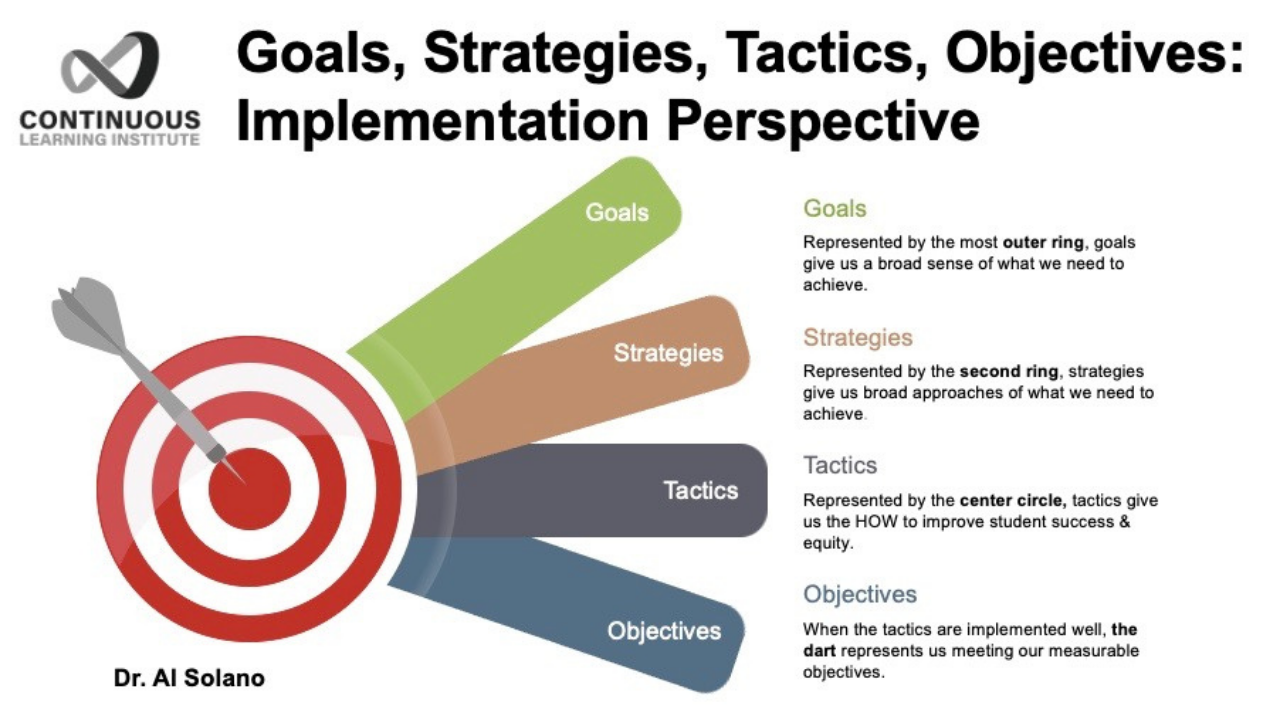Goals, Strategies, Objectives, & Tactics

Avoid confusion. Create common language and definitions for your institution's plans.
Institutions of higher education tend to lack common language and definitions around their plans. For example, I've seen numerous times how at the same campus the term "objective" is used to mean one thing in a strategic plan and yet it has an entirely different meaning in a strategic enrollment management plan. Not to mention the lack of alignment between existing plans and federal grant proposal terminology. For the sake of clarity, I'd like to focus on four terms: Goals, Strategies, Objectives, and Tactics.
Goals
Goals will vary by how the institution structures the plan. I've made sure that all institutions that I coach use a student journey framework. For example, Completion by Design or the four Guided Pathways pillars. When institutions use a student journey framework, the goals are what need to be achieved for each part of the student journey. For example, Allan Hancock College's Ed Master Plan goals focus on Connection --> Entry --> Progress --> Completion --> Transition.

The other advantage of a student journey framework, especially Completion by Design, is that data can be disaggregated per student journey point to better understand and address equity issues.
Strategy
A strategy is a broad method or approach for achieving the goals. For example, a strategy in the "completion" student journey goals could be:
Implement student success teams.
Objectives
An objective is a metric to measure implementation of a strategy or combination of strategies. For example, "By [year], equity gaps in persistence rates will be fully closed from a baseline of a X% gap between [x group] and [y group].
Implementing the plan:
Contrary to popular belief, it's not absolutely necessary to spell out the tactics in a plan because circumstances could dramatically change in the course of a plan's shelf life (plans can range 5 to 10 years). A pandemic is an example. Before the start of every academic year, the institution needs to review the plan, choose what strategies to focus on for the year, and decide on the exact tactics given the on-the-ground realities at the time.
Tactics
Tactics are specific actionable steps taken to implement a strategy. Tactics need to be assigned to specific individuals or groups and must include completion dates. Tactics represent what actually must be completed to successfully implement a strategy. For example:
To establish student success teams (strategy):
A design team will convene fall of [year] to write a plan of action to begin implementing virtual student success teams per academic & career pathway the spring of [year].
Team: student success team - design team [names & titles]
Responsible Person(s): Vice Presidents of Instruction AND Student Services
Of course, plans should also include vision, mission, and value statements, baseline data, and a chart showing the alignment between the plan and other existing plans, district plans (if applicable), and when necessary, state plans (e.g., California's community college's vision for success). I wanted to focus on four terms: goals, strategies, tactics, and objectives because of the lack of clarity at many campuses. I'm sure some people are thinking, "How about 'outcomes' and 'activities'?" Outcomes are the same as objectives and activities are the tactics. I can also hear, "But we've used 'objectives' to refer to strategies for years at our campus." Great! If you have common language across all of the college plans and grant proposals whereby 'objectives' are strategies, then don't change. You've accomplished creating common language at your institution.
The point is to make things easier for everyone to understand. Limit the use of terms and focus on creating common language and definitions at your institution. And please avoid 200-plus page plans. I've seen some with 300+ pages. With the exception of 1-3 people, no one else reads the entire confusing and dense document. Create a plan that's simple and straight-to-the-point. A plan people will actually read and implement.
Here's another way to look at it. From an implementation perspective using a target as a visual, the outer ring represents the goals. Goals give us a broad sense of what we need to achieve. The second ring in the target (closer to hitting the mark), represents strategies that give us broad approaches of what we need to achieve. The center circle represents tactics that give us the HOW to improve student success & equity. When the tactics are implemented well, the dart (hitting the mark) represents us meeting our measurable objectives.

Work smarter, not harder. Simplicity and relentless clarity is key.
***
Also visit: Integrated Planning Tools & Resources






